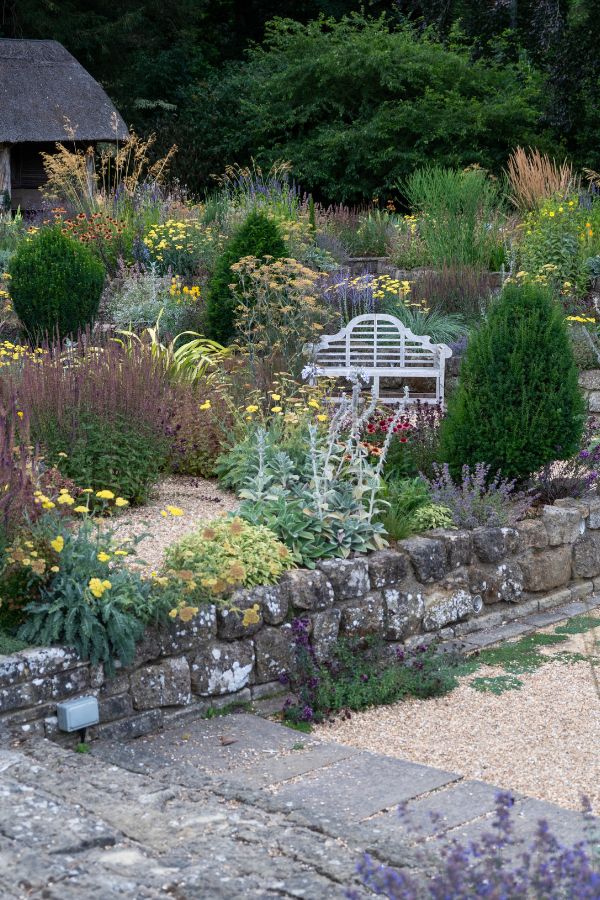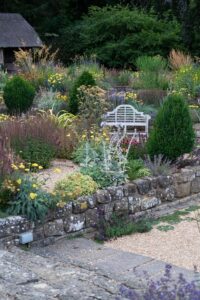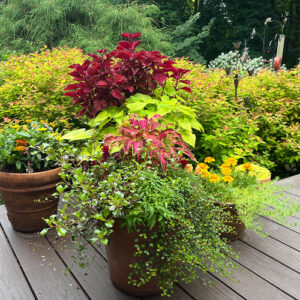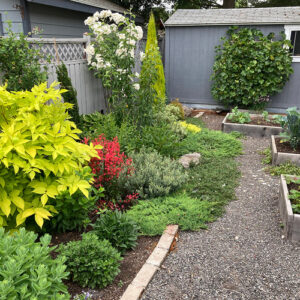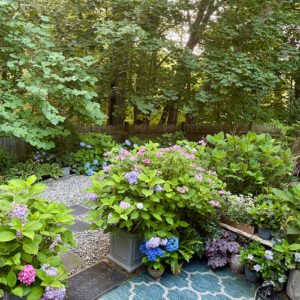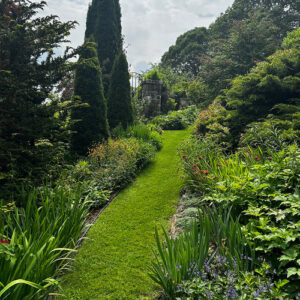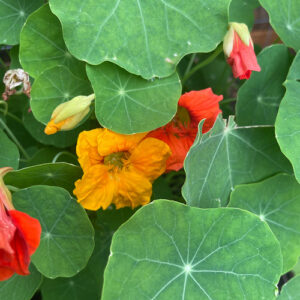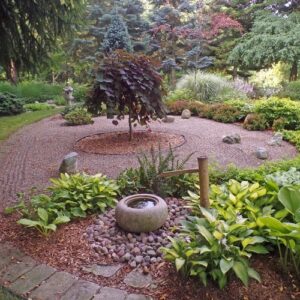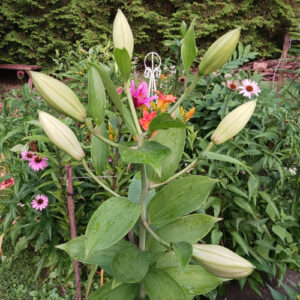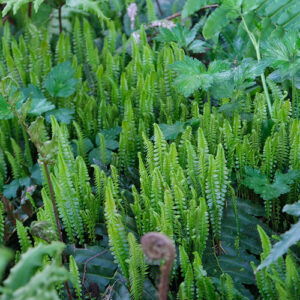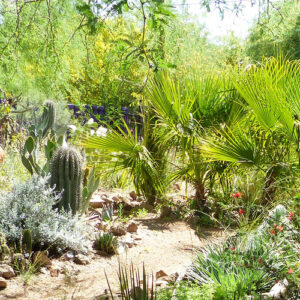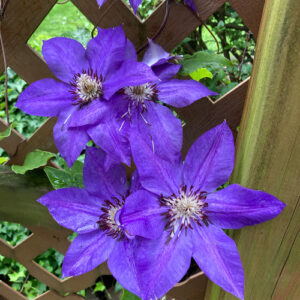August 7th, 2025 Posted In: Garden Trends & Design
Transform your borders with a sand garden! It’s a game-changing new trend in resilient gardening.
And it has nothing to do with beach style. Sand gardening is actually an alternative to the traditional herbaceous border.

Vibrant, wildlife-friendly sand garden planting: the Sunken Garden at West Dean Gardens in Sussex. This has garden has not been irrigated in spite of several months of drought. Head gardener Tom Brown estimates that this new gardening style is approximately 50% less work than their traditional flower borders.
This is a different, surprisingly effective way to garden with less water, less work, and more resilience. It is a softer-looking version of concrete-rubble gardening, which Tom has also done at West Dean.
Note that this isn’t a Zen garden either. A Zen garden is a minimalist landscape, based in sand, and is a garden style from Japan. Japanese zen sand gardens aim to create a relaxing, meditative environment.
The sand gardening I’m showcasing here borrows from influences around the world, but is a new gardening technique of its own.
To find out more, I visited West Dean Gardens in Sussex—famous for its restored Victorian glasshouses, grand Edwardian pergola, creative planting and tree-lined walks. It’s also home to West Dean College, who run world-leading courses in arts, design, craft and conservation.
There I spoke to Tom Brown, award-winning head gardener at West Dean, gardening writer for The Daily Telegraph and other national titles, and author of The Greenhouse Book: Make the Most of Your Greenhouse Throughout the Year.(affiliate link, see disclosure)
Tom has been trialling sand gardening, concrete-rubble gardening and other low-input methods for several years. His insights challenge traditional thinking—and offer real ideas that you could use at home.
Here’s what I learned from Tom, and how you could try a sand garden – or a concrete-rubble border – in your own garden.


I was blown away by how flowery and colorful the sand garden was, compared to some of the traditional herbaceous borders I’ve seen this year. The UK has had a warm, dry spring and an early hot summer with very little rainfall, punctuated by occasional storms. Not great for traditional gardening!
What Is a Sand Garden?
A sand garden is a border or planting area created by laying a 10cm layer of coarse sand over soil and planting directly into it. The aim is to grow plants in very low-fertility conditions, with excellent drainage and no irrigation once established.
You don’t use fertilizer either, even when you’re planting. These relatively tough conditions mean that plants grow less tall, so they don’t need staking.
It sounds harsh—but in fact, the sand layer insulates plant roots from extremes of hot and cold, holds moisture beneath the surface, and creates a habitat that suits drought-tolerant plants. It also protects them from winter wet by giving them a layer the roots can ‘retreat’ to in very wet winters.
And some plants flower more in challenging conditions, because they need to set seed. A lush environment can lead to more foliage and height, rather than more flowers. (See 6 Common Reasons Why Your Plants Aren’t Flowering – And How to Fix It.)
As Tom Brown explains: ‘We chose a community of plants that can be resilient to extremes—hot, dry summers and cold, wet winters. And the sand layer gives them that extra protection.’


The sand garden planting at West Dean enhances and echoes the countryside beyond. You can see how dry the lawns are in the top photo.
How to Create a Sand Garden – Step by Step
1. Choose a sunny spot
Sand gardens thrive in full sun. Avoid shaded areas or heavy, winter-wet soils unless you’re trialling a small patch.
Even if you have a sunny spot, Tom suggests you trial a small patch for a year – perhaps just a couple of metres square – to see how you enjoy this kind of gardening.
2. Lay a 10cm layer of clean, coarse sand
Use horticultural sand or coarse local quarry sand—check that it’s free from salts and other contaminants. Avoid leaf litter or compost: sand gardens need to stay low in fertility. The sand in West Dean’s Sunken Garden came from a local quarry, so it looks right for the countryside around it.
3. Plant small, young plants
Use 9cm or 1-litre pots so roots can reach through the sand into the soil.
Sit the top two-thirds of the rootball in sand; the bottom third in soil. Plant 40cm apart for good coverage in the early years.
4. Don’t irrigate or fertilize
Once established, plants are left to thrive on their own—no staking, no feeding, no watering. To find out more about how to minimise your garden watering, see Garden Watering Strategies: How To Save Time, Effort & Money.
5. Keep the sand clean
Clear away fallen leaves and old stems in late winter. Organic matter increases fertility by breaking down to provide a ‘soil layer’ in which weed seeds can germinate. This layer of new ‘soil’ can also rot stems.
So remove all old plant debris – it’s completely the opposite from Chop and Drop!
If you want to create some striking effects and keep some of the plant material for over-wintering invertebrates, then see Errol Fernandes’ ideas in New Ways of Gardening. He takes down stems and seedheads in early spring, but ties them up in sculptural bundles so that the hibernating insects can keep their homes until they’re ready to emerge.


This planting is in its first summer. Tom planted the plants 40cm apart to get good coverage, but gaps in sand garden planting are attractive too.
What Are the Benefits of a Sand Garden?
– No watering or feeding once established, so doesn’t use resources
– Less weeding (though you’ll still have to do some!) The sand acts as a mulch, preventing weed seeds in the soil from germinating
– Lower maintenance than traditional borders – there’s no staking as plants are usually sturdier
– Great for pollinators and biodiversity
– Protects roots in winter as well as summer
Tom says: “Our traditional herbaceous borders take approximately twice the amount of work. In the sand garden, we don’t water, feed, or mulch—and we enjoy just as much interest.”


The new sand garden in West Dean’s Sunken Garden with a before photo. The same view before and after planting the new garden.
What Plants Grow in a Sand Garden?
Tom is proving that drought-tolerant planting doesn’t have to be spiky or dry-looking. His favourite sand garden plants include:
- Echinacea
- Nepeta (catmint)
- Achillea (yarrow)
- Eryngium (sea holly)
- Bronze fennel – “great for pollinators and a soft structure plant”
- Species roses like ‘Mutabilis’. A species rose is an original rose that hasn’t been altered by rose breeding.
- Thyme lawns using low-growing ‘Creeping Thyme’ varieties such as ‘Elfin’ or ‘Pink Chintz’
- Grasses including Calamagrostis ‘Karl Foerster’, Stipa gigantea, and even dwarf pampas grass.
- Tom’s tip: “You can plant more densely—about 40cm apart—and even if you see a bit of bare sand, it’s not unattractive. It adds to the look.


Tom’s favourite echinacea for the sand garden is…
Can You Grow Bulbs in a Sand Garden?
Yes—Tom grows alliums, crocuses, and daffodils directly into the sand. Just watch out for mice, especially with crocus.


Sand garden plants include echinacea, yarrow, stipa grasses and nepeta (Catmint).
Does a Sand Garden Help the Soil?
Sand doesn’t feed soil biology like compost does—but it protects the soil underneath from erosion and compaction. Tom sees that as a worthwhile trade-off, particularly given the rich biodiversity for pollinators and reduced watering.
Tom says:“It’s hard to find any gardening method that doesn’t involve some compromise. But the benefits—especially in sustainability—are worth it.”


Tom says that Eryngium (Sea Holly) often fails to do well in traditional borders but it has thrived in both the sand and concrete gardens.
What About a Concrete or Rubble Garden?
Before creating the sand garden in the Sunken Garden, Tom experimented on a ‘Concrete Garden’ in a small area beyond the main college.
Tom created this by using a 10cm layer of crushed recycled concrete, spread directly on the soil like a mulch. It’s made from demolished buildings and prevents them from being sent to landfill.
A concrete rubble garden is planted using the same method. Approximately two-thirds of the plant roots are planted in the crushed, recycled concrete. One third is in the soil beneath.
They watered the garden once at planting time (three years ago) but haven’t watered it since.
Self-seeding plants flourish in this garden. In fact, some are so vigorous that the main gardening job is pulling them out. But Tom says that’s easier than constantly re-planting and I agree with him.
See this post for 25 brilliant self-seeding plants.
This approach is more industrial-looking, and not for everyone, but it offers similar environmental benefits: no watering, minimal weeding, and high pollinator activity.


The ‘Concrete Garden’ at West Dean: the entire area is planted in 10cm of concrete rubble from demolished buildings. The paths are created by gaps in the planting.“It questions our traditional aesthetics,” Tom says, “but the biodiversity it supports is incredible.”
Is a Sand Garden or a Concrete Garden Right for Me?
Best suited for:
- Sunny positions
- Free-draining or chalky soils
- Sloping gardens (See here for more Sloping Garden Ideas.)
- Gardeners looking for long-term low-maintenance planting
Avoid if:
- Your garden is shaded
- You have heavy clay or poorly draining soil.
- However, Tom thinks it could be worth trialling a small patch to see if it works. This is a relatively new form of gardening for traditional gardeners. We all still have a lot to learn about it, so don’t be afraid to experiment.
- If your garden is quite wet, on heavy clay soil and/or shady and you’d like to make it less work, then check out Anne Wareham’s approach in The Low Maintenance Garden That Looks Really Fabulous.
When Should You Start a Sand Garden?
Spring is best. It gives plants a full season to establish roots before their first winter. Autumn planting may lead to plant losses in cold, wet soil.


Echinacea is one of the pretty plants that flourish in both a sand and rubble garden.
Are Sand Gardens Just a New Fashion – Will They Go ‘Out of Date’?
Tom Brown believes that sand gardening isn’t just a trend, but a genuine solution to some of our gardening problems. It uses fewer resources – including your time or the cost of employing gardeners: ‘This style of planting offers resilience, beauty, and biodiversity—and we’re only beginning to explore what’s possible.’
It’s an experiment in practical, sustainable gardening from someone with years of experience at one of the UK’s most respected gardens.
If you were looking for seaside garden inspiration, then don’t miss How to Create a Delightful Seaside Garden.
And if your real love is still the traditional herbaceous border, Tom’s 12 tips for a stunning border has lots of good advice.
Tom also has brilliant tips for growing in a greenhouse. See Greenhouse Growing – How to Get More Flowers for Longer.
Pin to remember exciting new sand gardening
And do join us. See here for a free weekly email with more gardening tips, ideas and inspiration.


